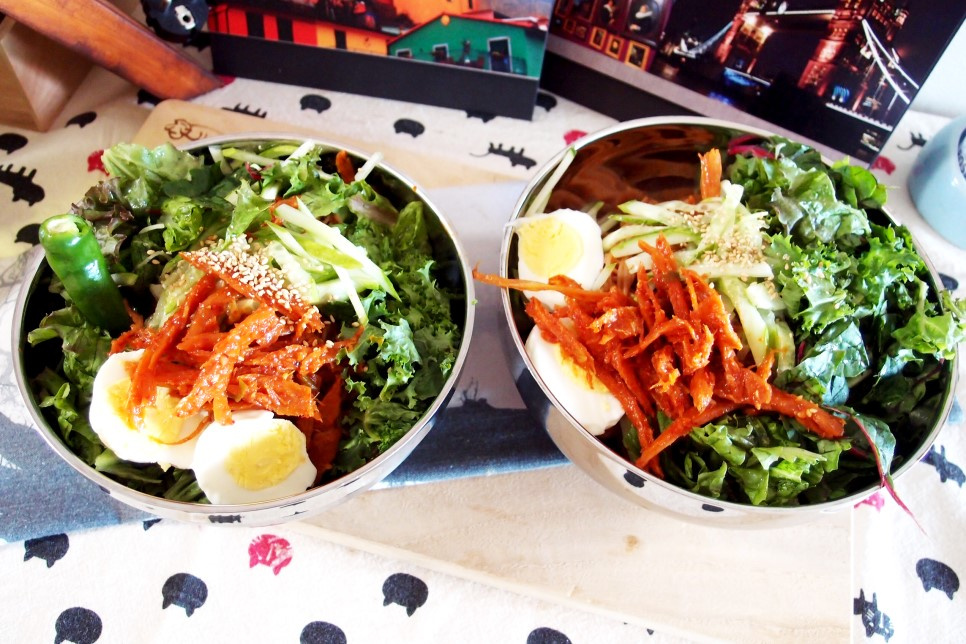Spicy & Tangy Dried Pollack Cold Noodles (Hwangtae Cho-muchim Naengmyeon)
#SummerFood #SummerDish #DriedPollackRecipe #HowToMakeChoMuchimNaengmyeon #CoolDownThisSummerWithDriedPollackColdNoodles!

This recipe creates delicious and refreshing cold noodles using a spicy and tangy seasoned dried pollack (Hwangtae Cho-muchim). First, we’ll prepare the Hwangtae Cho-muchim, a versatile side dish that requires no cooking. This flavorful mixture is then combined with chilled noodles for a perfect summer meal. The Hwangtae Cho-muchim itself can be enjoyed as a simple banchan, but we discovered it makes an absolutely fantastic main dish when paired with cold noodles! Using common pantry staples like gochujang, chili powder, and soy sauce, this Hwangtae Cho-muchim is incredibly easy and quick to make without any heat.
Dried Pollack Soaking Ingredients- 150g dried pollack strips (Hwangtaechae)
- 1/3 cup vinegar
- 3 cups water
Hwangtae Cho-muchim Seasoning Ingredients- 3 Tbsp sugar
- 3 Tbsp gochujang (Korean chili paste)
- 2 Tbsp gochugaru (Korean chili powder)
- 2 Tbsp Cheongju (rice wine) or mirin
- 5 Tbsp vinegar
- 3 Tbsp soy sauce
- 2 Tbsp minced garlic
- 2 Tbsp minced green onion
- 1 tsp minced ginger (or ginger powder)
- 2 Tbsp honey
- 1 Tbsp sesame oil
- 1 tsp sesame seeds
Hwangtae Cho-muchim Naengmyeon Ingredients- 3 cups Hwangtae Cho-muchim (prepared above)
- 1 Tbsp prepared mustard
- 1/2 cup cold water (for adjusting consistency)
- 2 servings buckwheat noodles (Naengmyeon)
- 2 hard-boiled eggs
- 1/3 cucumber (julienned)
- 5 large lettuce leaves (e.g., romaine, butter lettuce)
- 1 tsp sesame seeds (for garnish)
- 3 Tbsp sugar
- 3 Tbsp gochujang (Korean chili paste)
- 2 Tbsp gochugaru (Korean chili powder)
- 2 Tbsp Cheongju (rice wine) or mirin
- 5 Tbsp vinegar
- 3 Tbsp soy sauce
- 2 Tbsp minced garlic
- 2 Tbsp minced green onion
- 1 tsp minced ginger (or ginger powder)
- 2 Tbsp honey
- 1 Tbsp sesame oil
- 1 tsp sesame seeds
Hwangtae Cho-muchim Naengmyeon Ingredients- 3 cups Hwangtae Cho-muchim (prepared above)
- 1 Tbsp prepared mustard
- 1/2 cup cold water (for adjusting consistency)
- 2 servings buckwheat noodles (Naengmyeon)
- 2 hard-boiled eggs
- 1/3 cucumber (julienned)
- 5 large lettuce leaves (e.g., romaine, butter lettuce)
- 1 tsp sesame seeds (for garnish)
Cooking Instructions
Step 1
Since dried pollack strips are quite dry, they need a preliminary soaking to become tender and absorb flavor. First, mix vinegar and water in a 1:3 ratio to create a vinegar-water solution. While you could soak the dried pollack directly in vinegar, using a diluted solution ensures the vinegar is absorbed more evenly throughout the strips, preventing them from becoming too harsh.

Step 2
Add the dried pollack strips to the prepared vinegar-water solution. Gently toss and turn them to ensure each piece is coated. Let them soak for at least half a day or up to a full day for an even more tender result.

Step 3
I’ll be using the pollack that has soaked for about half a day to make the Hwangtae Cho-muchim.

Step 4
After soaking, squeeze out excess liquid from the pollack strips. Then, carefully remove any tough, central bones. While you can remove the bones before soaking, it’s often easier to do so after the pollack has softened.

Step 5
Here are the dried pollack strips after the bones have been removed.

Step 6
Tear or cut the prepared pollack strips into bite-sized pieces. Long strips can be cut with scissors, while thicker pieces can be pulled apart by hand for a more rustic texture. As you handle them, check for any remaining bones and remove them thoroughly.

Step 7
Add minced garlic and minced ginger (or ginger powder) to the prepared pollack. Ginger is crucial for eliminating any fishy or gamey odors from the pollack and adds a wonderful depth of flavor.

Step 8
Now it’s time to season! Add the Cheongju (rice wine, or use mirin if unavailable). This helps to mellow any harsh alcohol notes and adds a subtle sweetness and depth. Follow with gochujang (chili paste), gochugaru (chili powder), and soy sauce.

Step 9
For a touch of sweetness, add both sugar and honey. You can adjust the sweetness level to your preference.

Step 10
Mix the ingredients thoroughly, massaging the seasoning into the pollack strips with your hands. Don’t just gently mix; really ‘scrub’ the seasoning in to ensure it penetrates the pollack. Finally, add sesame oil and sesame seeds, and mix once more until well combined. This process will release some natural moisture, creating a beautifully seasoned dish.

Step 11
The Hwangtae Cho-muchim is now ready to be enjoyed as a side dish with rice. For the cold noodles, we’ll add a little water to the seasoned pollack to adjust the consistency.

Step 12
Let’s prepare the cold noodles! We’ll use fresh lettuce leaves and julienned cucumber as toppings for the Hwangtae Cho-muchim Naengmyeon. (Optional: thinly sliced chili peppers can add a nice kick.)

Step 13
Add the prepared Hwangtae Cho-muchim to the cooked buckwheat noodles. Stir in the prepared mustard for a bit of zest. Gradually add the cold water while vigorously mixing the noodles and the seasoned pollack until everything is well combined.

Step 14
Taste the noodles after mixing. If it feels a bit bland, add a little more gochujang or soy sauce. If it tastes too thick or heavy, a splash of vinegar can brighten the flavors. If the Hwangtae Cho-muchim mixture itself doesn’t have much liquid, you can create a separate sauce by mixing gochujang, vinegar, gochugaru, sugar (or honey), water, and soy sauce, then combine this with the noodles and pollack mixture.

Step 15
Transfer the well-mixed Hwangtae Cho-muchim Naengmyeon to a serving bowl.

Step 16
Finally, arrange the toppings: lettuce leaves, julienned cucumber, the seasoned pollack mixture, and the hard-boiled egg. Sprinkle with sesame seeds for a final touch. Enjoy your delicious and refreshing Spicy & Tangy Dried Pollack Cold Noodles!




